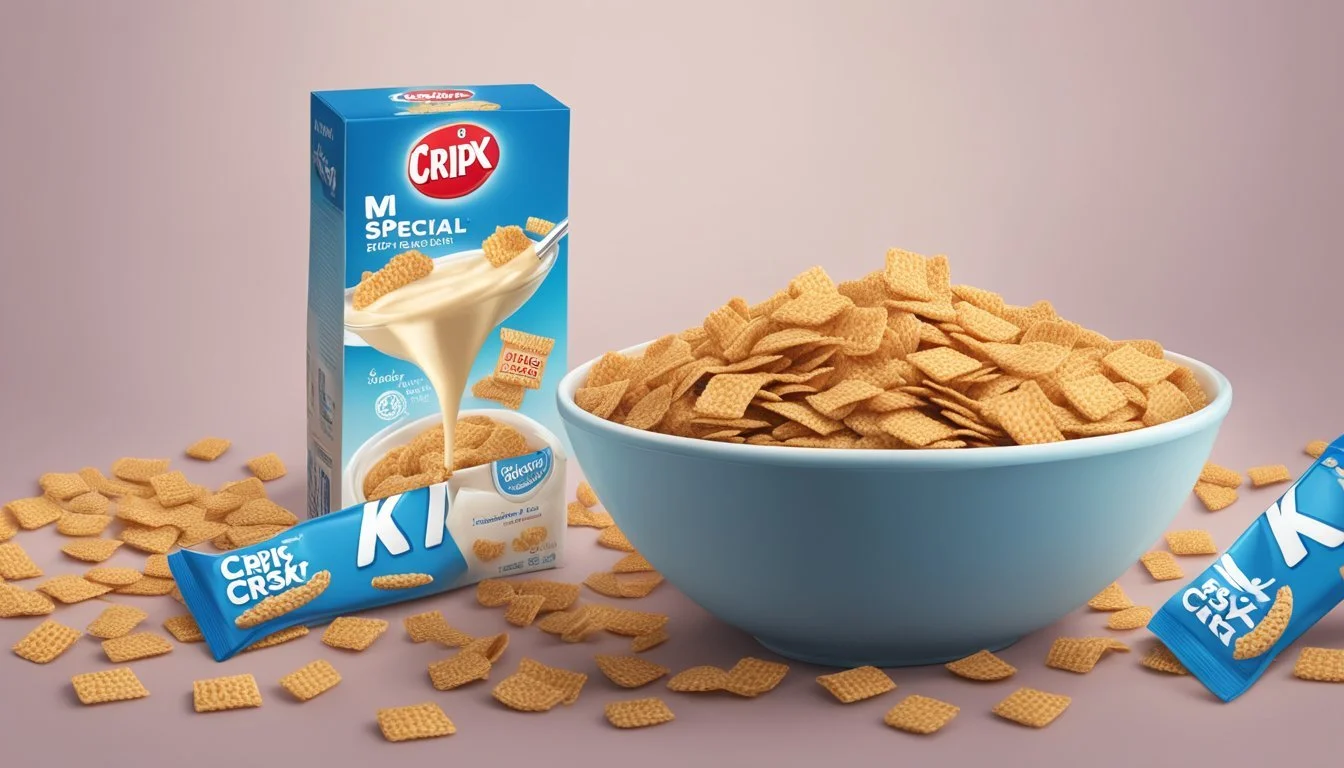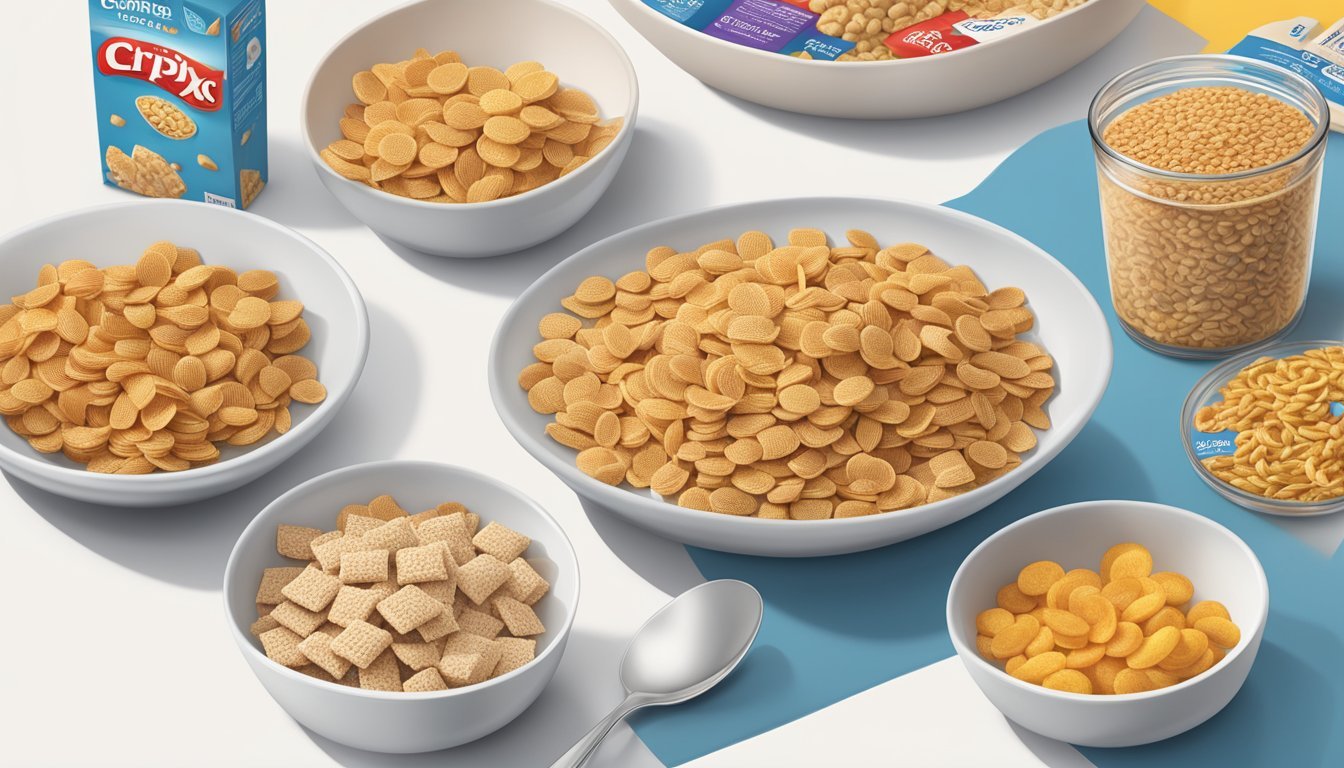Crispix vs Special K
Comparing Nutritional Content and Flavor
This Article is Part of Our Breakfast Cereal Guide with Details on Crispix Nutrition and Special K Nutrition
Choosing the right breakfast cereal can be a daunting task with so many options on the market. For those comparing Kellogg's Crispix and Special K, the decision often centers on nutritional benefits. Crispix boasts a higher zinc content with 5.19mg per serving, a notable difference from Special K’s 0.69mg. This can be an important factor for those looking to boost their immune health and metabolism.
Special K, renowned for its weight management marketing, provides a significant Vitamin B12 advantage. It offers 550% more Vitamin B12 than Crispix, which can be crucial for energy production and maintaining a healthy nervous system. Additionally, Special K contains 15.3mg of Vitamin E per serving, vastly surpassing Crispix’s 0.1mg.
When considering complex carbohydrates, Crispix offers more per serving with 21.0 grams compared to Special K’s 16.0 grams. This makes Crispix a potentially better option for sustained energy release. Both cereals have their unique strengths, making the choice dependent on individual nutritional needs and health goals.
Historical Background
The histories of Crispix and Special K reflect different strategies in the breakfast cereal market, with both brands introducing innovations and aiming to meet specific consumer needs over the decades.
Evolution of Crispix and Special K
Crispix was introduced by Kellogg's in 1983 to compete with Ralston Purina's Chex cereals, which dominated the market. Its unique feature of having crispy rice on one side and crunchy corn on the other helped differentiate it. By 1987, Crispix had achieved annual sales of about $65 million.
Special K was launched in the U.S. by Kellogg's in 1955. Made primarily from rice, wheat, and barley, it was marketed as a low-fat cereal for those aiming to lose weight. Over time, the brand expanded to include meal bars and other products. Following the 2023 spinoff from Kellogg's North American business, Special K continued to focus on health-oriented consumers.
Nutritional Profiles
When comparing Kellogg's Crispix and Special K cereals, several key nutritional differences emerge. Each cereal offers unique benefits, making them suitable for different dietary needs and preferences.
Caloric Content Comparison
Crispix and Special K vary slightly in caloric content.
Crispix: Approximately 110 calories per 1 cup serving.
Special K: About 120 calories per 1 cup serving.
Despite the minor difference, neither provides a significant caloric load, making both suitable for a calorie-conscious diet.
Macronutrient Comparison
Macronutrient content, particularly protein, fat, and carbohydrates, differs between Crispix and Special K.
Protein:
Crispix: 3 grams per serving.
Special K: 6 grams per serving, which is double the protein in Crispix.
Fat:
Both cereals have negligible fat content, hovering at 0 grams per serving.
Carbohydrates:
Crispix: Around 26 grams of carbs, with 3 grams of sugar.
Special K: Approximately 22 grams of carbs, including 5 grams of sugar.
Vitamins and Minerals Breakdown
Both cereals are enriched with various vitamins and minerals, though the specific content varies.
Crispix:
High in Vitamin B1, B2, B3, and Zinc.
Contains fewer vitamins such as Vitamin E and B12 compared to Special K.
Special K:
Rich in Vitamin B12, B6, E, Folate, Selenium, and C.
Notably, it provides 550% higher daily Vitamin B12 coverage.
Contains essential minerals like Iron, Calcium, and Phosphorus in more significant amounts.
Comparative data shows Crispix has 8 times more Zinc, while Special K excels in vitamins crucial for overall health. Both offer distinct nutritional advantages aligned with diverse dietary goals.
Ingredient Analysis
When comparing Crispix and Special K, it's important to understand the core ingredients that make up each cereal. This analysis focuses on these key components, highlighting their nutritional differences and unique features.
Breakdown of Core Ingredients
Crispix:
Crispix is primarily made from rice and corn. The cereal features a layered texture with crispy rice on one side and crunchy corn on the other. This combination results in a unique blend of flavors and textures.
Key ingredients for Crispix include:
Rice
Milled corn
Sugar
Salt
Barley malt extract
Special K:
Special K focuses on whole grains, which contribute to its higher fiber content. It also includes rice and wheat, making it a versatile choice for those looking for a balanced breakfast.
Key ingredients for Special K include:
Rice
Whole grain wheat
Sugar
Wheat gluten
Defatted wheat germ
Through this comparison, it becomes evident that Crispix offers a dual-texture experience with rice and corn, while Special K is centered on whole grain wheat, enhancing its nutritional profile.
Health Considerations
When comparing Crispix and Special K, it’s crucial to consider various health factors, including sugars, fats, sodium, and dietary fiber content. Each of these elements can influence dietary choices for those on specific diets such as low-fat, low-carb, or low-glycemic index diets.
Sugars and Fats
Crispix and Special K differ significantly in their sugar and fat content. Crispix typically contains about 3 grams of sugars per serving, while Special K has a slightly higher sugar content at about 4 grams per serving.
In terms of fats, both cereals are relatively low-fat options. Crispix contains 0.3 grams of total fat per serving, while Special K has around 0.7 grams of total fat per serving. This makes both cereals suitable for a low-fat diet.
Sodium Content
Sodium levels in breakfast cereals can be a concern, especially for those managing hypertension.
Crispix contains approximately 220 mg of sodium per serving. Special K, on the other hand, has a higher sodium content, with around 290 mg per serving.
Individuals on a low-sodium diet may prefer Crispix due to its lower sodium content.
Dietary Fiber Content
Dietary fiber is important for digestive health, and it’s beneficial in managing weight and blood sugar levels.
Crispix offers about 0.7 grams of dietary fiber per serving, which is quite low. In contrast, Special K provides 1 gram of dietary fiber per serving.
While neither cereal is particularly high in fiber, Special K has a slight edge in this regard.
Healthier Choice
Determining the healthier choice between Crispix and Special K depends largely on individual dietary needs. For those on a low-sodium diet, Crispix may be preferable due to its lower sodium content.
Individuals focusing on a low-fat or low-calorie diet will find both cereals acceptable.
Special K, being slightly higher in fiber, may be more suitable for those looking to manage digestive health and blood sugar levels.
Product Varieties
Special K and Crispix each offer a range of options that cater to different tastes and dietary needs. These varieties provide a way for consumers to enjoy their favorite cereal while meeting specific nutritional requirements or flavor preferences.
Special K Variants
Special K offers a wide array of variants that cater to various dietary and taste preferences. Popular options include Special K Original, which is known for its basic, crispy flakes enriched with vitamins and minerals.
There are also flavored varieties like Special K Red Berries, incorporating freeze-dried strawberries, and Special K Chocolatey Delight, which integrates chocolate pieces for a sweet treat.
For those seeking higher protein content, Special K Protein provides a more substantial meal. Special K also has options catering to specific health goals, such as Special K Low Fat Granola or Special K Fruit & Yogurt, blending tastes and textures for a diverse breakfast experience.
Crispix Variants
Crispix is primarily sold in its original, distinct form of crispy rice on one side and crunchy corn on the other. This dual texture is a hallmark of Crispix, making it unique in the cereal market.
While the original Crispix remains the most recognizable, there have been limited-edition variations introduced from time to time, targeting seasonal flavors or special occasions. These limited releases often capture consumer interest for their novelty but are not permanent fixtures in the Crispix lineup.
Overall, Crispix's focus remains on their original product, which continues to be popular for its straightforward and appealing mix of tastes and textures.
Consumer Preferences
Consumers often weigh various factors when choosing between Crispix and Special K, particularly focusing on taste and texture.
Taste and Texture
Crispix is renowned for its unique blend of flavors and textures, consisting of crispy corn on one side and crunchy rice on the other. This combination makes it an appealing choice for those who enjoy a dynamic eating experience.
Special K, with its light, flaky texture, appeals more to individuals seeking a simpler, cleaner cereal taste.
Taste preferences vary widely among consumers. While some appreciate the more robust flavor of Crispix, others prefer the milder, more refined taste of Special K. The texture also plays a significant role; Crispix's dual texture offers a unique crunch, while Special K provides a more traditional cereal feel.
Market Presence and Availability
Crispix and Special K, both produced by Kellogg's, have a significant market presence and wide availability. Both cereals are well-known and available across various retail and online platforms globally.
Retail and Online Distribution
Crispix and Special K are widely distributed across numerous retail outlets, including major supermarket chains like Walmart, Kroger, and Target.
In addition to physical stores, these cereals are extensively available online through platforms such as Amazon, Walmart.com, and the official Kellogg's store. Online reviews and customer ratings indicate strong consumer satisfaction for both brands. The convenience of online shopping has also bolstered their presence in the market, making them accessible to a broader audience.
Special K has a broader variety of flavors and types, such as Special K Red Berries and Special K Protein, which are prominently displayed in both physical and online storefronts. Crispix may have fewer flavor variations, but its distinct texture and taste ensure it maintains a loyal consumer base.
Global Reach
Kellogg's products, including Crispix and Special K, are not confined to the United States. They enjoy global availability, with significant market penetration in Europe, Asia, and Australia.
In countries like the UK and Canada, Special K is particularly popular, often promoted for its nutritional benefits. Marketing campaigns in these regions emphasize health and wellness, resonating well with local consumers. Crispix is also available in many international markets, often found in the breakfast aisle of large supermarket chains.
Availability in diverse regions ensures that both cereals cater to the breakfast needs of varying demographics. Their consistent presence in international markets reflects Kellogg’s strategic efforts to maintain and grow its global footprint.
Environmental and Ethical Considerations
Environmental and ethical considerations play a significant role in the assessment of cereals like Crispix and Special K. They impact decisions related to sustainable production, resource utilization, and corporate responsibility.
Sustainable Production
Crispix and Special K are produced by Kellogg’s, a company with commitments to sustainability. Sustainable production involves minimizing environmental impact across the supply chain.
Kellogg's focuses on reducing greenhouse gas emissions and water usage. They have set targets for responsible sourcing of ingredients and reducing packaging waste. Efforts include using renewable energy sources and enhancing supply chain transparency.
Special K might have an edge due to its high nutrient density, potentially translating to lower life cycle impacts. Both cereals undergo processes aimed at ethical labor practices and reducing their carbon footprint.
Conclusion
Nutrition:
Crispix contains more complex carbohydrates per serving compared to Special K, with 21.0 grams versus 16.0 grams.
On the other hand, Special K provides higher coverage for Vitamin B12 and significantly more Vitamin E, boasting 15.3 mg of Vitamin E against Crispix's 0.1 mg.
Healthier Choice:
Determining which cereal is healthier depends on one's nutritional needs.
For someone seeking higher zinc content, Crispix is the better option, providing 5.19 mg compared to Special K's 0.69 mg.
Those aiming for better vitamin coverage, especially Vitamin E and B12, might find Special K to be the healthier choice.
Crispix:
Complex Carbs: 21.0 grams
Zinc: 5.19 mg
Vitamin E: 0.1 mg
Special K:
Complex Carbs: 16.0 grams
Zinc: 0.69 mg
Vitamin E: 15.3 mg
A person's dietary requirements and health goals will greatly influence which of these cereals is the optimal choice for them. Each has its unique nutritional strengths and applications.









